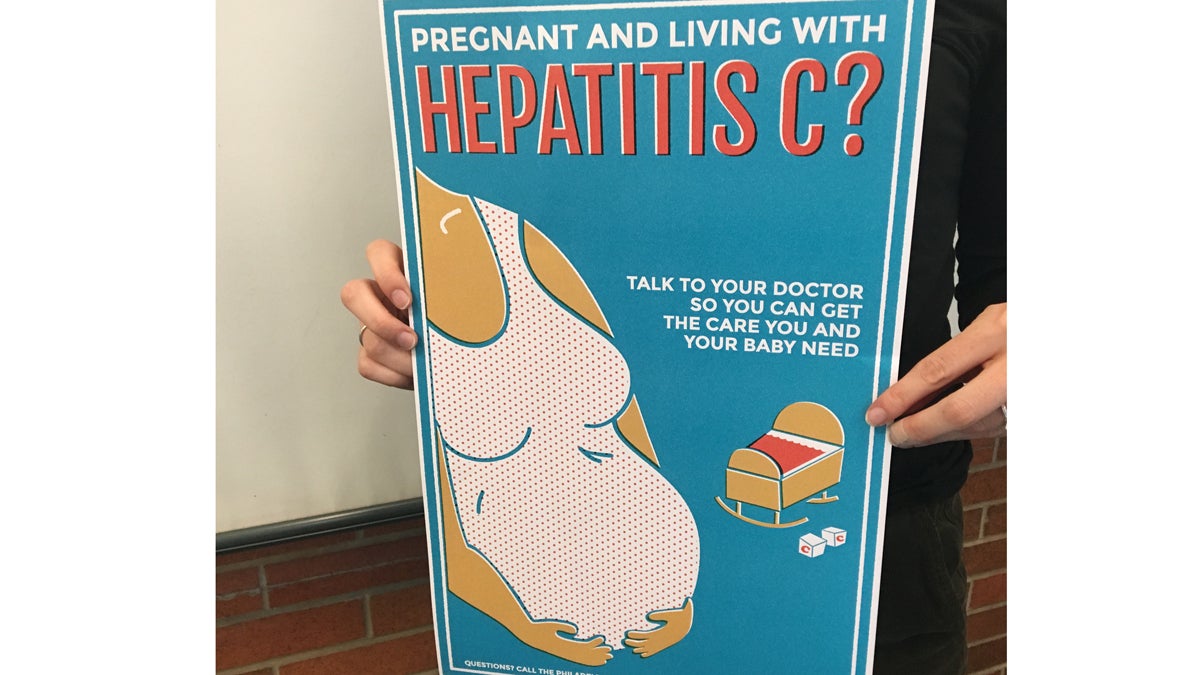Philadelphia study raises concerns that babies exposed to hepatitis C slipping through cracks
Listen
Danica Kuncio, hepatitis epidemiologist for the city of Philadelphia, holds an outreach sign aimed at pregnant woman with hepatitis C. (Elana Gordon/WHYY)
A new study found that eight out of ten new borns at high-risk for hepatitis C in Philadelphia were not screened for the condition, raising alarm among some providers that a new generation of children will go without treatment.
Hepatitis C is the most common blood-borne infection in the country and a leading cause of liver failure. The 15-percent screening rate among the newborns of moms who were registered as having the condition is worrisome, according to epidemiologist Danica Kuncio, who led the study.
“Fifteen percent is really low,” Kuncio said. “When you think about children, you hope that the number would be 100 percent, that it should be in the interest of every provider to be doing the best they can to get information to the next provider.”
A new wave of drugs has dramatically changed the treatment landscape for hepatitis C. With access to these potentially expensive medicines, the condition has gone from chronic and debilitating to curable. The developments have shifted conversations and interventions. Philadelphia has launched more targeted screening efforts, but for pregnant women who have Hepatitis C, their newborns may still be falling through the cracks.
The new Philadelphia analysis, which used city surveillance data, found that of the approximately 500 moms-to-be who were registered as having Hepatitis C, 84 of their newborns, or about 15 percent, were then screened for the virus. Kuncio, an epidemiologist with the city, worries that means the rest of those kids, unaware of their diagnosis, won’t ever know if they’ve developed hepatitis C and then get connected to special care.
Kuncio is not pointing fingers at any one person or pointing to any one solution. While such gaps have been studied in Australia and Europe, it still marks new territory in the U.S. That’s in part because hepatitis C is tricky. Unlike HIV and hepatitis B, which are universally screened for in pregnant women, there isn’t a lot one can do to prevent hepatitis C transmission from mother to child at birth. There also aren’t a lot of treatment options for newborns. Meanwhile, HCV may remain silent for years, with symptoms not manifesting until liver damage has already begun.
But while the mother-to-child transmission rate for hepatitis C is low, with one to five percent of children born to HCV-positive moms developing a chronic infection, Kuncio says that still means at least two dozen children just based on city surveillance data have likely developed the infection and won’t know it. Four children in the study were confirmed to have HCV.
Meanwhile, she and others think recent developments with hepatitis C drugs could eventually change care options for infants, making it all the more important improve the screening and treatment protocols now in place.
“Maybe you can’t prevent the transmission, but maybe you can treat the child earlier and prevent any downstream longterm effects…and spreading it to peers and family members inadvertently,” she said.
“The old dogma was why screen mothers if there’s nothing to be done?” said Dr. Regino Gonzalez-Peralta, a pediatrician specializing in hepatology at the University of Florida Health System in Gainesville who’s also been studying the inadequacies of identifying children infected with HCV. “Now we’ve got drugs that potentially might be useful in preventing maternal-fetal transmission. This is going to become a hotter area.”
For Dr. Damien Croft, an obstetrician at Hahnemann hospital in Philadelphia who was not involved in the study, the findings underscore questions currently being debated in his department: how to improve screenings of at risk moms and better coordinate with those who care for them and their children once they leave the hospital? The guidelines aren’t as clearly defined for hepatitis C, he says, and there’s a data-sharing issue.
“It really is connections and communication between providers, obstetricians and pediatricians,” said Croft, who says if pediatricians don’t know that a child is at risk for having contracted hepatitis C, they won’t know to test for it. That means it’s up to everyone to do a better job of sharing that information.
Kuncio, meanwhile, thinks many more children and moms may have likely fallen through the cracks, since the study only looked at women who had been screened for the virus. Many others might have it but not know it, she says, because the general protocols for screening “at-risk” women has shortfalls. For example, what if a woman is uncomfortable admitting a history of injection-drug use to an obstetrician, which would then flag her to be screened?
She says the general rise in injection drug use also means that rates of hepatitis C rates could be going up among women of childbearing age, making these issues all the more important to address.
Dr. Croft, with Hahnemann, isn’t sure universal screening is the answer, though it’s one that’s starting to be debated in some medical circles. But he acknowledges “there’s enough woman who are high risk for hepatitis C in Philadelphia that maybe we should consider doing that.”
Last year, a Philadelphia Health Department study found that overall, about three percent, or some 47,000 Philadelphia residents, have HCV.
WHYY is your source for fact-based, in-depth journalism and information. As a nonprofit organization, we rely on financial support from readers like you. Please give today.

